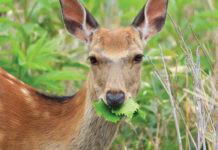In today’s economy and competitive marketplace, small businesses must be nimble and efficient to remain profitable. Turf maintenance is a successful niche market for many landscape and lawn service contractors, and adding additional services can result in a bigger bottom line with relatively little startup investment. Turf maintenance often includes pest control, so a natural expansion would be pest control for trees (and shrubs as well). If you are licensed and/or certified to apply pesticides to turfgrass, tree pest control can give you a means to climb your way to bigger profits.
As a member of the green industry, undoubtedly friends, neighbors and family members have asked you questions about plants. Why not use that knowledge by responding to these same questions from customers and potential customers. A running joke among horticulturists is that upon asking what kind of plant has the problem, the response is, “It has green leaves.”
As a professional you know how to dig deeper and come up with the correct response and appropriate solutions to solve these types of problems.
Making a diagnosis without seeing the tree itself can be risky, to say the least. At a minimum, you need to know the tree species. There are several ways you can acquaint yourself with trees in your region. Your local cooperative extension service is a great resource. Independent nurseries are very helpful, as well.
If you are digitally inclined, Virginia Tech has a free app for both Apple and Android users that can be helpful. There’s a wealth of books, from simple to the sublime. In the former category is “What Tree is That?” by the Arbor Day Foundation. Much more comprehensive is “Dirr’s Encyclopedia of Trees and Shrubs” by Michael Dirr. Many arborists consider it a must-have book.
Knowing the tree species is critical; sometimes a natural stage of a tree can look like a malady to an untrained eye. For example, pollen on pine or spruce is often mistaken for insects or diseases. Yellowing or leaf drop in the interior of a tree can be normal. Honey locust trees naturally have yellow leaves, and dawn redwoods are deciduous conifers that drop their needles.
What’s wrong with my tree?
Once you know the tree species, you can begin to narrow down the problem. Sometimes, this can be relatively simple. If you live in the Midwest or Northeast and are looking at an ash tree and see canopy dieback from the top of the tree, plus metallic green insects, you can probably bet it’s emerald ash borer, an imported pest that is wreaking havoc in an expanding range.
On the other hand, if a tree is exhibiting browning leaves, it could be anything from abiotic (non-living disorders such as drought, heat or salinity) to any number of diseases or even a nutrient deficiency. Obviously, spraying an insecticide on a tree that has a fungal infection or is in need of a deep irrigation is not only wasteful, but can cause additional damage.
In order to make an educated diagnosis, note and describe the signs and symptoms exactly. Symptoms are changes in the tree’s growth or appearance (a thinning canopy in an ash tree). Signs are direct evidence that a pest or disease is present (the shiny green insects or larval feeding galleries below the bark). Take pictures and make notes as to the location on the tree.
More great resources
You will need reference materials to help you determine the cause of the problem. Insect and disease identification of trees and woody plants has been the subject of countless regional books. “Diseases of Trees and Shrubs” by Wayne Sinclair and “Insects that Feed on Trees and Shrubs” by Warren T. Johnson would both be an excellent investment if you plan on offering tree pest services. In addition, you can find information on regional pests at your cooperative extension or department of agriculture office.
Next, you will need to ask about past management. If a tree has been under drought stress, has had its roots cut for construction projects or has been severely pruned and wounded, that can affect the treatment you select. String trimmer damage around the base of the tree in turf can lead to decline and death.
If it sounds like diagnosing can be tough, it is. Some arborists build an entire career around diagnosing tree problems, but if you are willing to educate yourself and stick to common problems in your area, you can still offer responsible pest control.
To spray or not to spray?
Depending on the pest or disease, the first option may be no treatment at all. Sometimes weather conditions are right for an aphid explosion, but a few days later ladybird beetles and birds can literally wipe out the population to tolerable numbers. Or perhaps the aphids can be blasted off with water sprays. If a tree is under drought stress, a deep irrigation might be all it needs. Adding a 3- to 4-inch layer of organic mulch (keep it away from the tree trunk) under the canopy is a sound management option for almost any tree.
If chemical treatments are warranted, there are several methods. If you have a spray rig, insecticides or fungicides can be applied into the tree’s canopy. Be sure that the leaves are all evenly covered.
If using an aerial spray, use the lowest pressure and largest droplet size possible to minimize drift. Do not spray if the wind is more than 10 mph, and stand upwind to minimize your contact with the spray. Needless to say, be sure to wear proper personal protective gear and study the product label.
Read more: Tree Trunk Injection Benefits
Avoid spraying when temperatures are above 85 degrees Fahrenheit. Spray all around and through the canopy, paying attention to covering the leaves and growing tips. Apply the pesticide so that it wets the foliage, but does not run off.
While aerial spraying used to be the preferred method for pest control, today it is falling out of favor. With more consumers questioning the use of pesticides, a spray rig shooting anything into a tree canopy is a conspicuous candidate for public complaints.
Cruising the vascular highway
Other methods of tree pest control involve using the tree’s own system to distribute the chemical throughout its structure. Trees absorb water and nutrients through the roots, which then move up to the trunk, branches and stems using a vascular system that lies almost directly below the bark. “Systemic” insecticides reach all parts of the tree.
Soil drenches or injections are a discrete means of applying pesticides that can be effective in many cases. These techniques can be used for application of imidacloprid, dinotefuran (Safari) and some growth regulators. When using a soil drench, chemicals are mixed with water and applied to the soil near the tree’s root crown. Using a water-soluble chemical is required. Be sure the soil is moist, but not saturated.
If the soil is mulched, pull the mulch away before applying and then replace it when the application if finished. The rate and timing of application depends on the pest, chemical used and size of the tree.

Soil injection is similar, but is best achieved with specialized equipment. The system consists of a wand that can penetrate the soil to a depth of 2 to 4 inches. Either a backpack or a pressurized spray rig can be used to deliver the product.
Trunk basal spraying, sometimes called bark banding, is another low-impact means to apply pesticides. With this technique, the chemical is sprayed on the bottom few feet of the trunk on the bark. In this case, you need a dry trunk surface for optimum application.
Tree pest control requires acquiring a new skill set. The International Society of Arboriculture has regional chapters throughout the United States (and worldwide) that offer seminars and literature to help newcomers to the industry learn the tools of the trade. In addition, the networking opportunities can lead you to even more work offering responsible pest control.
While tree pest control is certainly not for everyone, it offers a viable means to a wide range of income-enhancing opportunities.











![[VIDEO] Dickies®: Discover Workwear That’s Anything But Uniform](https://turfmagazine.com/wp-content/uploads/2023/06/1647663814-4b1a2a7742790a9b1e97a3b963477850192e1d6a9dfba9b07214a77bae25d6e3-d-218x150.jpg)

































![[VIDEO] Dickies®: Discover Workwear That’s Anything But Uniform](https://turfmagazine.com/wp-content/uploads/2023/06/1647663814-4b1a2a7742790a9b1e97a3b963477850192e1d6a9dfba9b07214a77bae25d6e3-d-324x160.jpg)